Speak directly to the analyst to clarify any post sales queries you may have.
The neurovascular intervention devices market is undergoing transformational growth, propelled by continuous innovations that enhance clinical outcomes and expand procedural options for treating complex cerebrovascular conditions. Senior executives navigating this sector require timely market intelligence, actionable segmentation, and a clear understanding of shifting regulatory and geopolitical impacts.
Market Snapshot: Neurovascular Intervention Devices Market
The Neurovascular Intervention Devices Market advanced from USD 4.25 billion in 2024 to USD 4.53 billion in 2025 and is projected to grow at a CAGR of 6.69%, reaching USD 7.14 billion by 2032. This expansion demonstrates robust demand, innovation momentum, and increasing procedural adoption across major global regions, especially as the burden of stroke and related disorders escalates. Consequently, industry participants are optimizing offerings for hospitals, clinics, and ambulatory centers, ensuring clinical efficacy is matched by operational efficiency.
Scope & Segmentation of the Market
This research offers a comprehensive analysis of the neurovascular intervention devices landscape, spanning key product innovations, regional dynamics, and end-user demands.
- Product Types: Embolic Agents (including liquid and particulate variants); Flow Diverters (Pipeline Embolization Device, Surpass Flow Diverter); Microcatheters (Hydrophilic Coated, Polymer Coated); Neurovascular Coils (Detachable, Pushable); Stents (Balloon Mounted, Self Expanding); Thrombectomy Devices (Aspiration Devices, Stent Retriever).
- Indications: Aneurysm, Arteriovenous Malformation, Stroke.
- End Users: Hospitals, Clinics, Ambulatory Centers.
- Procedure Types: Embolization, Flow Diversion, Thrombectomy.
- Geographic Coverage: Americas (United States, Canada, Mexico, Brazil, Argentina, Chile, Colombia, Peru), Europe, Middle East & Africa (United Kingdom, Germany, France, Russia, Italy, Spain, Netherlands, Sweden, Poland, Switzerland, United Arab Emirates, Saudi Arabia, Qatar, Turkey, Israel, South Africa, Nigeria, Egypt, Kenya), Asia-Pacific (China, India, Japan, Australia, South Korea, Indonesia, Thailand, Malaysia, Singapore, Taiwan).
- Leading Companies: Stryker Corporation, Medtronic plc, Johnson & Johnson, Penumbra, Inc., Boston Scientific Corporation, Terumo Corporation, Becton, Dickinson and Company, MicroPort Scientific Corporation, MicroVention, Inc., Kaneka Corporation.
Key Takeaways for Senior Decision-Makers
- Technological advances are redefining the standards for minimally invasive treatment of cerebrovascular conditions, with products increasingly tailored for physician usability and patient safety.
- Integration of AI and real-time imaging is delivering improved precision for device navigation and lesion assessment, influencing clinical best practices and accelerating market adoption.
- Collaborative models involving device manufacturers, academic health systems, and payers are supporting faster innovation and validation, while also addressing cost-effectiveness and value-based care imperatives.
- Agility in supply chain management is becoming mission-critical due to evolving regulatory requirements and tariff environments, spurring industry-wide shifts towards regional production and quality assurance optimization.
- Emerging market regions, especially Asia-Pacific and selected Middle Eastern economies, are unlocking new opportunities with increasing healthcare infrastructure investments and procedural volumes.
- Personalized medicine strategies are on the rise, leveraging digital health platforms and advanced data analytics to enhance post-procedural outcomes and patient engagement.
Tariff Impact: Strategic Considerations for 2025
Recent United States tariffs on imported medical components have introduced substantial complexity to the cost structure for neurovascular device manufacturers. Companies are adapting through localization initiatives, renegotiating supplier contracts, and leveraging domestic production partners. These shifts are not only affecting supply cost but also triggering renewed focus on intellectual property risk and quality management. Healthcare providers are carefully assessing these changes, as procurement strategies and reimbursement negotiations are influenced by potential pricing fluctuations.
Methodology & Data Sources
This research integrates primary interviews with interventional neuroradiologists, procurement executives, and industry experts across top global regions. Insights are triangulated with peer-reviewed journals, clinical trial data, and proprietary industry databases, ensuring robust, validated findings that reflect both real-world practice and current technological developments.
Why This Report Matters
- Empowers senior leaders to optimize strategic plans, product portfolios, and go-to-market approaches by leveraging in-depth market segmentation and competitive benchmarking.
- Enables proactive risk management by addressing tariff implications and regulatory shifts in core and emerging markets.
- Supports evidence-driven decision-making through transparent methodology and actionable insights tailored for high-impact investment and partnership initiatives.
Conclusion
The neurovascular intervention devices market is defined by continuous innovation, dynamic competitive forces, and shifting regional opportunities. Leveraging this focused intelligence enables executive leaders to navigate market complexity, sustain competitive advantage, and plan for resilient, long-term growth.
Additional Product Information:
- Purchase of this report includes 1 year online access with quarterly updates.
- This report can be updated on request. Please contact our Customer Experience team using the Ask a Question widget on our website.
Table of Contents
3. Executive Summary
4. Market Overview
7. Cumulative Impact of Artificial Intelligence 2025
Companies Mentioned
The companies profiled in this Neurovascular Intervention Devices market report include:- Stryker Corporation
- Medtronic plc
- Johnson & Johnson
- Penumbra, Inc.
- Boston Scientific Corporation
- Terumo Corporation
- Becton, Dickinson and Company
- MicroPort Scientific Corporation
- MicroVention, Inc.
- Kaneka Corporation
Table Information
| Report Attribute | Details |
|---|---|
| No. of Pages | 193 |
| Published | October 2025 |
| Forecast Period | 2025 - 2032 |
| Estimated Market Value ( USD | $ 4.53 Billion |
| Forecasted Market Value ( USD | $ 7.14 Billion |
| Compound Annual Growth Rate | 6.6% |
| Regions Covered | Global |
| No. of Companies Mentioned | 11 |









